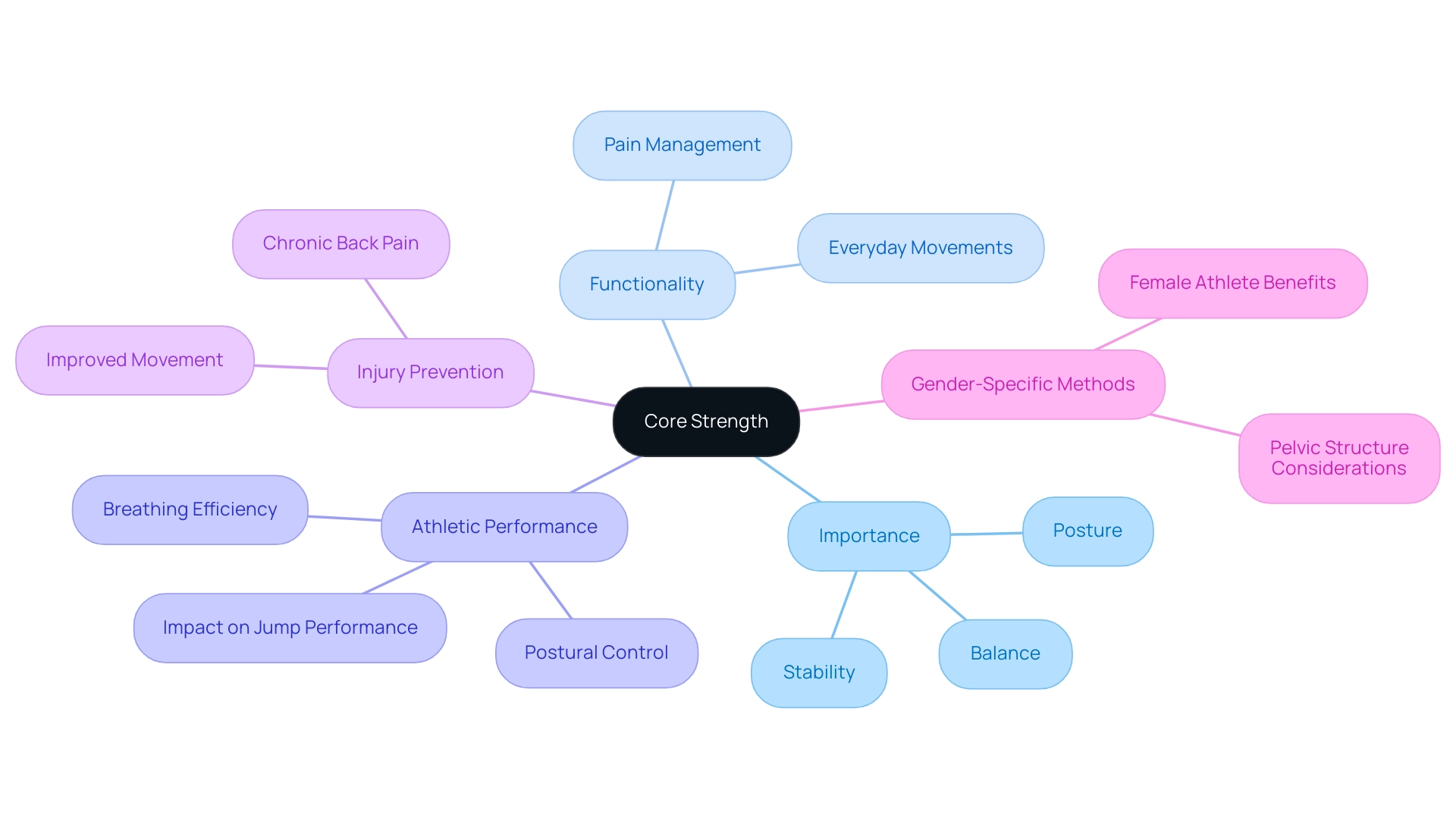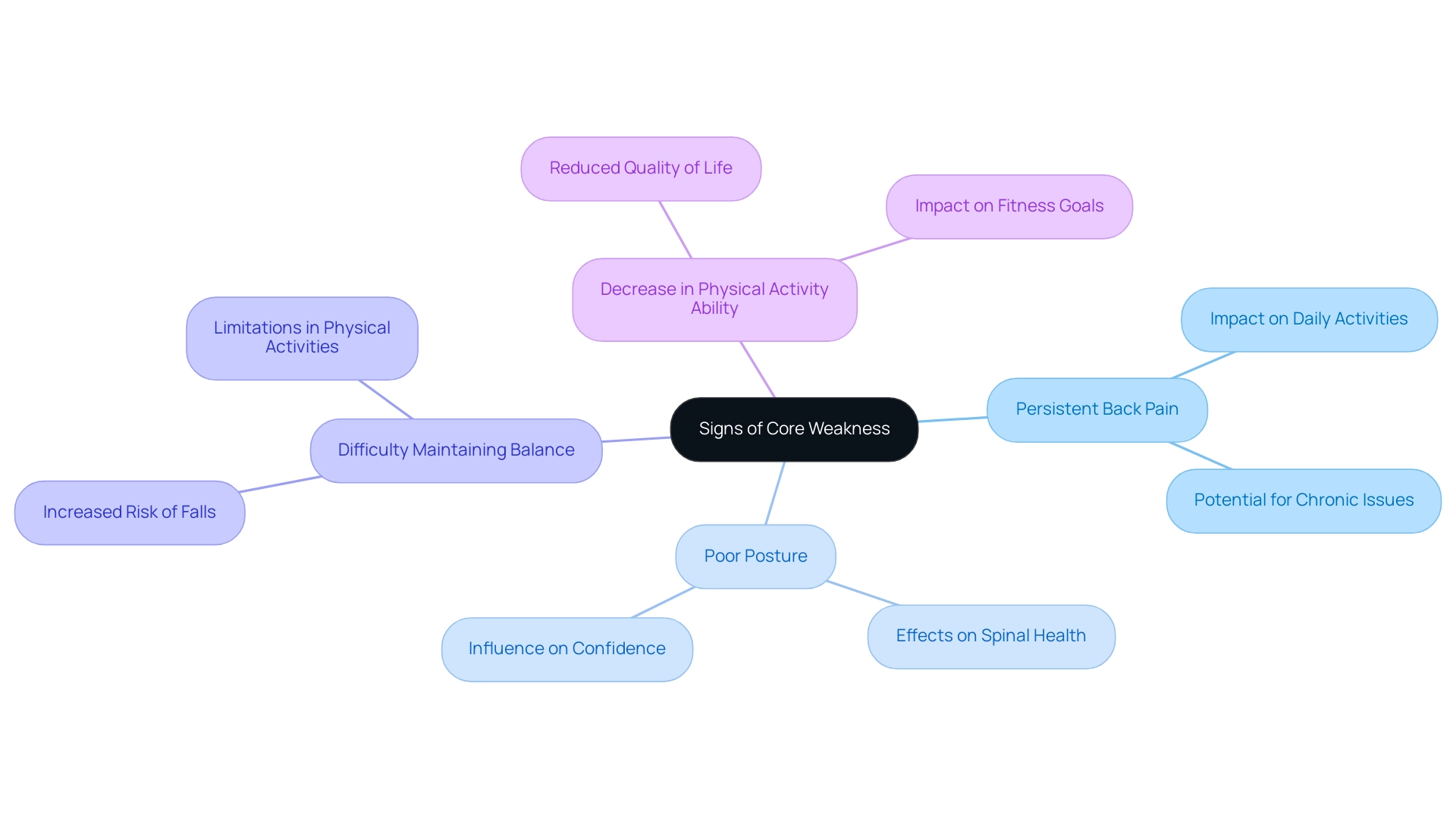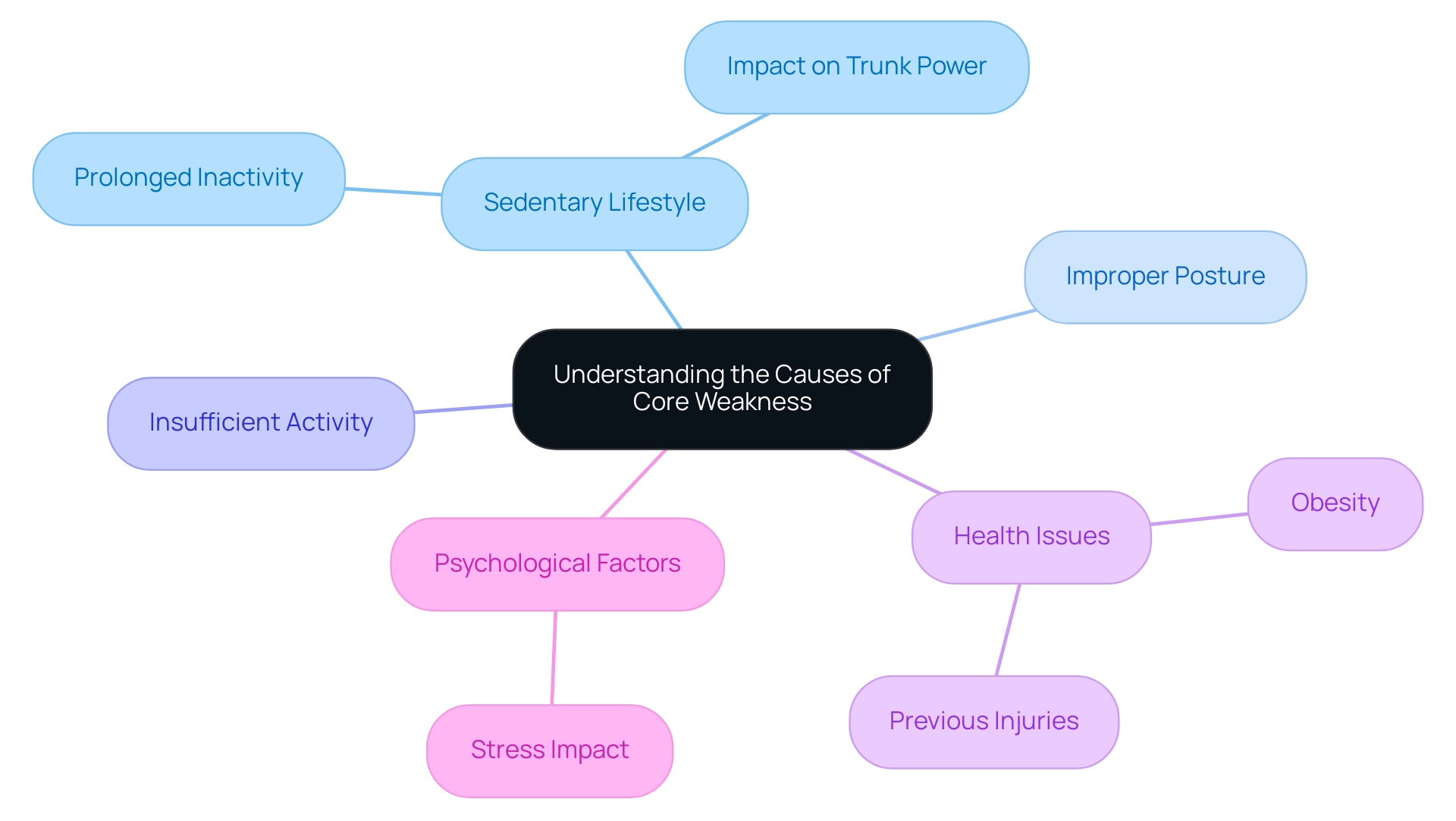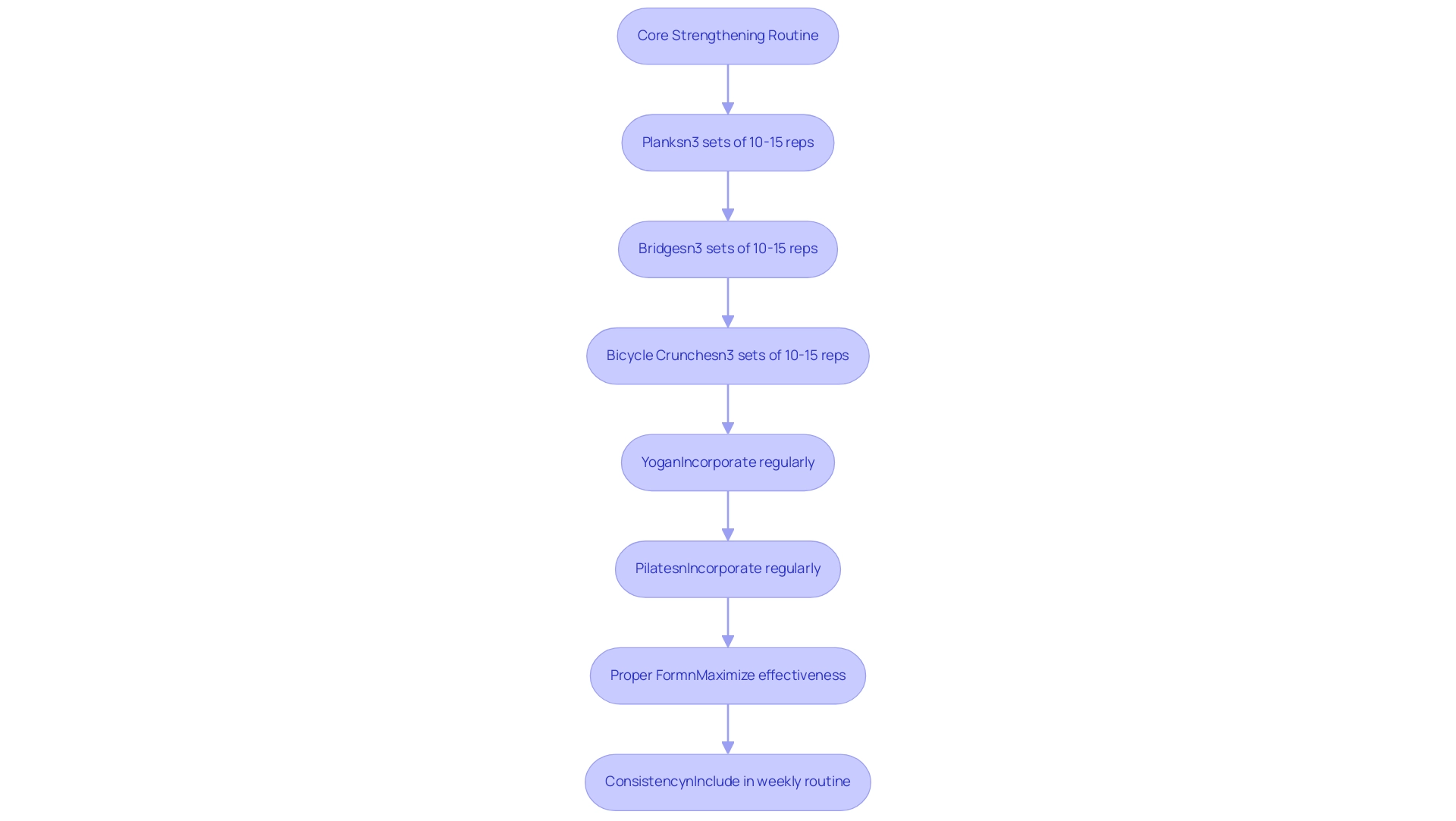Overview
The article focuses on understanding and strengthening a weak core, emphasizing its critical role in overall physical health, athletic performance, and injury prevention. It supports this by detailing the importance of core strength for stability and posture, identifying common signs of weakness, exploring causes such as sedentary lifestyles, and recommending effective exercises like planks and yoga to enhance core stability and functionality.
Introduction
In the pursuit of optimal health and performance, the significance of core strength cannot be overstated. It serves as the foundation for virtually every physical activity, influencing everything from athletic prowess to everyday movements. A strong core enhances stability, improves posture, and plays a critical role in injury prevention, making it essential for both athletes and those seeking to enhance their quality of life.
As recent research highlights the transformative effects of core strength training, it becomes clear that recognizing the signs of core weakness and implementing effective strategies to strengthen this vital area is paramount. By fostering awareness and prioritizing core stability, individuals and teams can embark on a journey toward improved performance, well-being, and resilience.
The insights shared in this article will empower readers to take actionable steps toward cultivating a robust core, ultimately leading to a healthier and more active lifestyle.
Defining Core Strength: Importance and Functionality
Core strength encompasses the stability and strength of the muscles in the abdomen, lower back, hips, and pelvis, forming the foundation for nearly all physical activities. Its importance extends beyond athletic performance; it is pivotal for everyday movements like lifting, bending, and sitting. A strong foundation is essential for maintaining balance and proper posture, which directly contributes to injury prevention and supports overall physical function.
Recent research highlights that individuals with strong abdominal muscles exhibit enhanced postural control and breathing efficiency, in contrast to those with a weak core, who often experience chronic back pain and poor posture. Remarkably, a study discovered a high variability (≈ 60%) in balance and vertical jump performance, suggesting that trunk power significantly impacts these elements of athletic performance. One compelling study spanning 18 months revealed that combining resistance training with dietary changes resulted in a remarkable 19% reduction in body fat mass, emphasizing the transformative impact of foundational fitness on physical wellness.
Moreover, Han Wang from the Faculty of Physical Education at Hainan Normal University indicates,
The application of essential conditioning training not only supports the efficiency of sprinters' training but also results in the enhancement and improvement of sprint training methods.
This insight emphasizes the athletic advantages of central training. Significantly, recent discoveries indicate that female athletes might benefit even more from such training because of variations in pelvic structure, highlighting the necessity to consider gender-specific methods in foundational training.
Therefore, addressing the issues related to a weak core is not just an option; it is an essential approach for improving both athletic ability and daily functionality, resulting in better pain management and injury prevention.

Recognizing the Signs of Core Weakness
Identifying the signs of a weak core is essential for enhancing overall health and well-being. Common indicators of a weak core include:
- Persistent back pain
- Poor posture
- Difficulty maintaining balance
- A noticeable decrease in ability during physical activities
These symptoms are not just minor inconveniences; they represent a significant opportunity for improvement.
By noticing and tackling these indications of a weak core, you can embark on a journey toward greater stability—crucial for improving effectiveness and quality of life. Personalized coaching and experienced guidance can empower your team to take control of their health and well-being, making lasting lifestyle changes. Dr. Weinberg's research highlights the importance of such awareness, reinforcing how proactive measures can lead to better health outcomes.
His findings, supported by grants from the National Institutes of Health, lend credibility to this approach. Additionally, consider the findings from the Vollenbroek‐Hutten study, a randomized controlled trial involving 163 participants with chronic low back pain. Those in the exercise group underwent an 8-week program, including conditioning training, swimming, and additional therapies, leading to remarkable improvements in function and health-related quality of life.
Significantly, sixty percent of participants provided yoga followed the program, demonstrating the possible involvement in activities that improve fundamental stability. One satisfied client noted, 'The personalized coaching I received transformed my approach to fitness and improved my overall well-being.' Take these insights to heart, as acknowledging these symptoms, coupled with personalized coaching, is the first step toward strengthening a weak core and building a healthier team.
Reach out to us today to arrange a consultation and begin your journey towards improved stability and performance.

Understanding the Causes of Core Weakness
The issue of a weak core is multifaceted and can arise from several factors, including sedentary lifestyles, improper posture, and insufficient physical activity. Recent findings suggest that a sedentary lifestyle significantly contributes to a weak core, with studies demonstrating that prolonged inactivity negatively impacts lateral trunk power and abdominal endurance. For example, studies assessing young individuals aged 13 to 18 years and adults aged 18 to 65 years emphasize worrying patterns in fundamental stability decline.
Anant et al. and Fadhil et al. found significant differences in lateral trunk strength and abdominal endurance, reinforcing the need for proactive measures.
Furthermore, studies published in journals like 'Preventive Medicine' and 'Workplace Health & Safety' have shown that employees who engage in regular exercise—specifically, at least 30 minutes three times per week—report feeling more motivated and engaged at work, leading to reduced absenteeism and presenteeism. Dr. Melody Ding's case study highlights the extensive advantages of physical activity, including enhancements in mental health and cognitive functions, especially in older adults, which further reinforces the significance of an active lifestyle for preserving fundamental integrity. Furthermore, health issues like obesity and previous injuries can undermine the integrity of a weak core.
It's essential to acknowledge that psychological factors, including stress, can also affect our capacity to engage primary muscles effectively. By understanding these causes and tackling them directly, you can create a healthier, more active atmosphere for your team, ultimately improving their overall well-being and effectiveness.

The Benefits of Strengthening Your Core
Enhancing your center is a fundamental aspect for attaining various health and achievement advantages. A strong foundation not only enhances your posture but also significantly boosts athletic performance and stability, particularly for those with a weak core, in everyday activities. Research, registered under the study number CRD42022371302, indicates that individuals participating in strength-building exercises experience a notable reduction in injury risk—an essential factor for maintaining an active lifestyle.
Respected fitness specialist Johannes Fleckenstein asserts, 'Enhanced central muscle stability relates directly to improved balance and injury avoidance, particularly for those with a weak core.' This aligns with findings from a recent investigation titled 'The Effects of Progressive Resistance Training on Muscle Power,' which revealed consistent improvements in muscle performance across various populations, demonstrating the profound impact of resistance training on overall physical capability.
By prioritizing fundamental strength through Foresight Health Coaching's corporate partnership, you can foster a healthier, more active environment for your team. This not only motivates them to excel in sports and daily tasks but also improves overall team effectiveness. Furthermore, by joining our corporate partnership, you can access a transformative health coaching app with a free 7-day trial. This opportunity supports your wellness goals and strengthens team culture, driving your organization towards greater success.

Effective Exercises and Strategies to Strengthen Your Core
Strengthening your weak core is essential for enhanced performance and overall well-being. To effectively build foundational stability and strengthen a weak core, incorporate exercises like planks, bridges, and bicycle crunches into your fitness routine. Aim for at least three sets of 10-15 repetitions for each exercise, progressively increasing the intensity as your strength improves.
Furthermore, incorporating activities such as yoga and Pilates, which have been demonstrated to effectively improve stability in individuals with a weak core, can offer considerable advantages. For instance, a study published in Tohoku J Exp Med in 2020 demonstrated that stability and hip exercises improved physical function in patients with non-specific low back pain. Notably, EMG activity measurements indicate that the rectus abdominis (RA) shows 51% activation, the external oblique (EO) 45%, the erector spinae (ES) 37%, the internal oblique (IO) 23%, the multifidus (MUL) 16%, and the transversus abdominis (TA) 3%, highlighting the varying levels of engagement during these exercises.
Maintaining proper form is crucial; it maximizes effectiveness while minimizing the risk of injury. As Kellis (2020) indicated in the Journal of Functional Morphology and Kinesiology, stability exercises can result in considerable enhancements in tissue thickness. Recent trends also indicate that yoga and Pilates are increasingly recognized for their core-strengthening benefits, especially for those with a weak core, as practitioners experience notable improvements in activation.
The research named 'Implications for Rehabilitation and Training' highlights that the exercises showing considerable increases in muscle thickness could aid in faster recovery and might be advantageous for coaches and trainers to integrate into training routines centered on stability. Consistency is essential; strive to include fundamental workouts in your weekly routine to observe significant improvements in both performance and recovery. Remember, the journey to a stronger core is one of empowerment, resilience, and commitment to your well-being.

Conclusion
Core strength is undeniably the cornerstone of both athletic performance and everyday functionality. By understanding its importance, recognizing the signs of core weakness, and addressing the underlying causes, individuals can take proactive steps toward enhancing their overall health. The evidence presented highlights how a robust core not only prevents injuries but also improves posture, balance, and performance in a range of activities.
Implementing effective core strengthening exercises such as:
- Planks
- Bridges
and engaging in practices like yoga and Pilates can lead to significant health benefits. These strategies not only enhance physical capability but also foster a culture of well-being within teams. As organizations prioritize core strength training, they empower their members to achieve greater resilience and performance.
Now is the time to recognize the transformative potential of core strength. By investing in core training, individuals and teams can unlock a path to improved health, enhanced performance, and a more active lifestyle. Embrace this journey and take actionable steps toward cultivating a strong core, paving the way for a healthier future.




